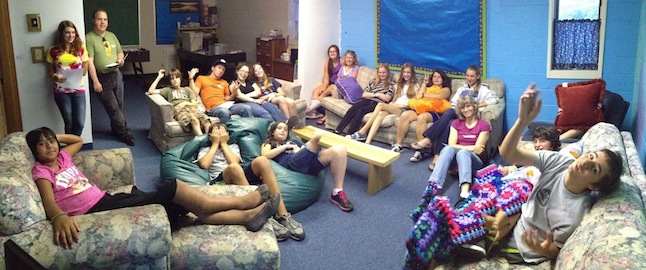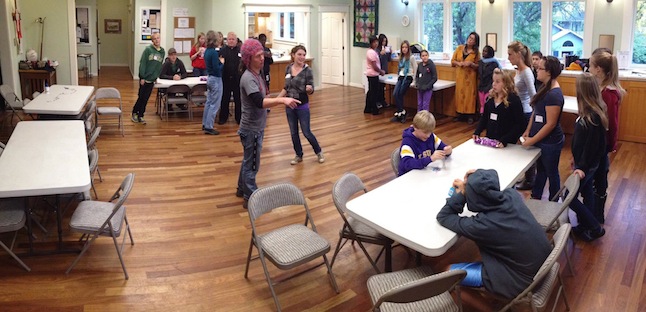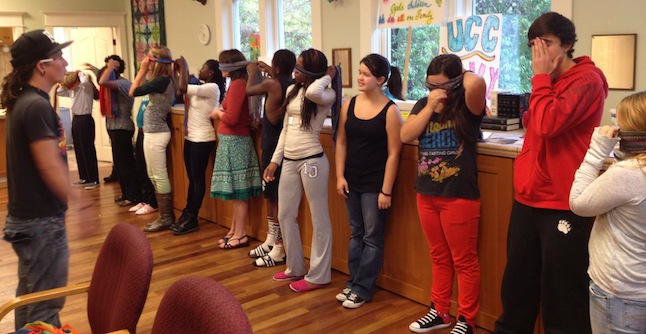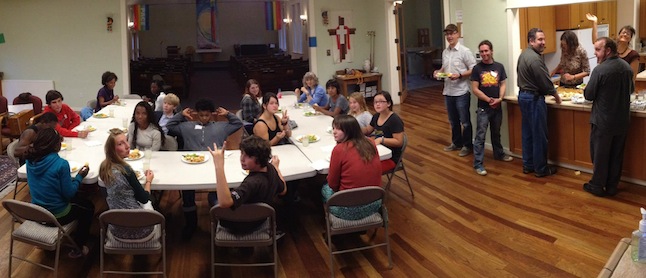
When I was interviewing for this position in Ashland, I shared about how my friend Greg Bolt helped start the Bend Youth Collective, and how I thought that it could be a good model for youth ministry in Ashland. My first week on the job, I met with a 1/4-time youth worker from the UCC church in Ashland to talk about the possibility of partnering with their church for our youth ministry. We tried scheduling a few activities, and had some moderate success.
We then had our two churches join up for a mission trip this summer, and that actually helped solidify some of the relationships between the youth. And then this fall, we gathered a few more churches together, and launched the Ashland Youth Collective as an ecumenical, progressive community youth group for the Presbyterian, UCC, Methodist & Episcopal churches in Ashland (you can read a lot more about our hopes and dreams here). I wanted to share some about our experience, now that we’re a few months in.

Why Join Together
I think that ecumenical and collaborative youth ministry really is the way forward, especially for smaller churches. When I first arrived here, we’d have youth groups that would range from between 1 and 8 or 9 kids. The other churches had a few youth who attended, but didn’t have active youth ministry programs.
Simply put, we could do more together. We could be better together. In my experience in youth ministry, I think critical mass is key! This isn’t to say that if just a couple kids show up for something, that it wasn’t worth doing. But in order to gain some energy and get kids excited and interested about coming to youth group, I think you must have critical mass. We didn’t have that at the Presbyterian Church. And none of the other churches did. But now, when we’ve joined together, we do. And kids are inviting their friends…something that really wasn’t happening before.
Aside from critical mass, it makes sense in a small town like Ashland, where almost all of these kids go to the same middle school or high school, for these kids to see churches partnering together, and not getting caught up in ‘loyalty’ or ‘allegiance’ to our specific denominations. I think that sends a good message for a group of children and youth for whom denominational loyalty won’t even exist.

Getting Started & Logistics
I got together with pastors from the 3 other churches and shared a vision for what the Ashland Youth Collective could become. We borrowed heavily (both in ideas and in PR/written materials) from the Bend Youth Collective. But essentially, we just brainstormed what our hopes would be for the youth of our churches, and how we could all partner together to help move toward making that happen.
As I mentioned above, last spring we had monthly Ashland Youth Collective (AYC) events, that helped the kids start to get to know one another. Then we had a mission trip which included youth and leaders from two different churches. I think the youth who went on this trip really helped to form the core of the AYC group. Then this past summer, the pastors and leadership met together and figured out our game plan. We launched in September and have been meeting as a combined youth group each week since then.
We have leadership from each of the churches, and so have a leadership team that consists of 9 adults. This is amazing and makes it so fun. Each community was responsible for coming up with a primary core leader (essentially the staff person) and a couple other committed volunteers. Being able to work with a team like this has been one of the best parts of the AYC.
We decided that in the beginning, we would rotate to each of the different church campuses. We started at the Presbyterian church for September, UCC for October and then we’ll be at the Episcopal Church for November. The hosting church takes care of planning the programming and arranging for the meal, and then we are all on-hand to help lead the activities and hang out with the youth.
We talked about some of our goals and hopes for programming, and we decided that we wanted to start off with a formula (which is, admittedly, a pretty traditional formula) for our time together. We meet from 5-7pm and this is typically what it looks like:
- 5:00-5:30: Ice Breakers and Community Building
- 5:30-6:00: Sharing a Meal Together
- 6:00-6:30: Lesson/Small Groups/Activity/Spiritual Practice
- 6:30-7:00: Games

Communication & Getting the Word Out
I became the point person for PR/communication for the AYC, and so we have been working on that in a variety of different ways.
- Text Messaging: Everyone knows that youth don’t check their email, so we opted with texting as our primary mode of communication with the youth. I used Tatango a few years ago, and liked their service, so we’re back with them. It costs about $20/month and we’ve had good response from the youth so far.
- Email Newsletters: In the past 6 months, I’ve become a huge fan of Mailchimp. They offer an amazing, free email newsletter service, and although I know I’m barely scratching the surface of the powerful features they offer, it’s been great. I collected email addresses from the staff of each of the churches for youth and adults, entered them all into one spreadsheet, uploaded it into Mailchimp, and there is your email base. It took me awhile to create the basic template that I wanted, but once that was done, I just log in each week and send out a reminder email for our week’s activities. You can see a sample here. I’m still learning the art of writing these emails, and recently ran across good advice suggesting that you send different versions of the same email: one that is very brief and short for youth, and longer and more informative for parents.
- Facebook Page: You can find our Facebook page here. Our group is pretty young (majority is middle schoolers) and many of them aren’t on Facebook, but we do have some high schoolers and parents and church folk who have liked us, and frankly, it’s a good place to share videos, photos and help get the word out to people in our respective faith communities.
- Tumblr Site: We started a Tumblr page for our mission trip this summer, and it’s become our website for the time being. I don’t see a purpose in creating a stand-alone website at this point, as this seems to get the job done.

My Hopes
Frankly, a lot of my hopes have been realized. We see kids excited to come to AYC. They’re inviting their friends. We have an ecumenical group of youth from the four progressive churches in Ashland establishing friendships, community and coming together to explore faith. A few weeks ago, some of the youth made a mission statement for our group, which is a pretty good explanation of who we are and what we do:
“We are a collective of youth in the Rogue Valley, with welcoming and affirming open doors, seeking a better understanding of God and Jesus while serving others and having fun with open hearts.â€
I’m excited about what we’re doing and think it offers a great alternative for smaller churches and those who are interested in exploring collaborative youth ministry. We definitely got the idea from the Bend Youth Collective, but there are other “collectives” starting to spring up as well, which is exciting. Check out the work of Morgan Schmidt and the Youth Collective in Seattle, and some urban San Francisco churches are coming together to form a collaborative youth group as well (video here). I think for many churches, this is the future of youth ministry, and I hope folks will be willing to try it out and see where God might lead them.